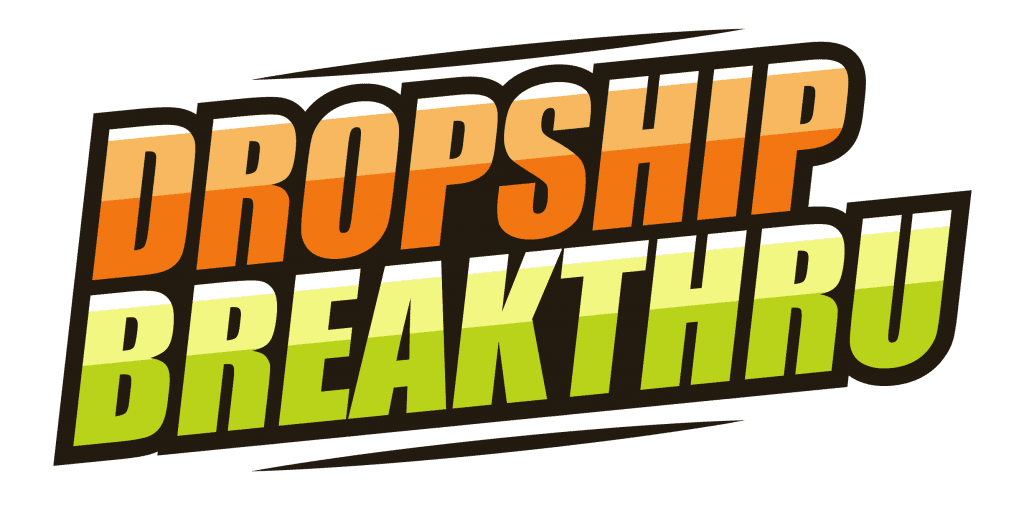7 Simple Steps to Finding Dropshipping Products

There’s no magic formula for success in the Ecommerce world – but understanding how to find dropshipping products that sell for high ticket prices can give you an edge.
And while others might tell you to sell low-cost products in huge volumes, we zig where they zag.
We recommend high ticket dropshipping, which means selling products with an average price of $800 or more sourced from local manufacturers based in the country you’re selling to.
But the catch is knowing how to find dropshipping products that are high ticket, in demand, and will be profitable long term. No easy task … but not as challenging as you might think!
For now, read on for a dive deep into the world of high ticket dropshipping and get our top strategies for how to find products.
Watch it on YouTube Or Listen To The Podcast
Where to Find Dropshipping Products (Not-So-Secret Sources)
Many of the people who join our programs come in with one idea for a product they can sell. Worried (quite rightly) about going all-in on a single, untested product, they ask, “What if my idea doesn’t work out?”
If you follow our steps for generating and evaluating ideas to see if they’re profitable, you won’t be locked into only one possibility. You’ll come up with a ton of great product ideas.
You’ll be surprised at all of the options you’ll uncover when you keep your eyes open and excavate these sources:
Look for Online Community Hangouts
People with a passion or hobby love to hang out online talking with other enthusiasts. They endlessly research, buy, and upgrade their hobby-related gear, which is why enthusiast communities make profitable Ecommerce niches.
So you’ll be looking for hobbies, activities, or interests where people spend a lot of time and money – anything from kitesurfing to high-end coffee. Things people want to do, not things they have to do.
There are literally hundreds (dare I say thousands) of online communities and social sites that are specifically for niche enthusiasts. These sites can be a treasure trove of potential ideas for high ticket dropshipping products.
Check out these possibilities to gather ideas:
- Forums and discussion boards: Sites like Reddit, Quora, and niche-specific forums are filled with threads where enthusiasts discuss their interests.
- Social media groups: Many enthusiasts discuss their hobbies, interests, and passions in Facebook groups, Instagram and Twitter hashtags, and Pinterest boards.
- Product review sites and blogs: Many niche-specific sites feature reviews of high ticket items, which can give you an idea of the products valued in those communities.
- Webinars and online classes: These platforms often attract people willing to invest in their interests (particularly if they’re paid platforms). Look at the tools, equipment, or products people recommend in these classes.
Remember that your research isn’t just about identifying potential products when scouting these online communities. You also want to get a deeper understanding of why community members value particular products.
What features do they appreciate? What problems do the products solve for them?
Remember, you have to care about the person on the other side of the screen!
Tap Into Google Trends
Using Google Trends is like having your finger on the pulse of the consumer world. You can use it to analyze the popularity of search queries across the US and gauge current market demand. This can give you a leg up in identifying high ticket items that have gained a foothold in the marketplace.
To start, type a broad keyword into Google Trends related to your product idea or niche.
For example, you might start with “infrared saunas” and refine by region, time period, category, and type of search (web, image, news, Google Shopping, or YouTube). Remember that you can do high ticket dropshipping in any country with an existing Ecommerce market – so do a search for the country you want to sell from.
Google will show you interest over time in that particular product, with a score from zero to a hundred – 100 meaning high interest and 0 indicating no interest. You can even review the past five years to see how interest has gone up and down over time.
If you see consistent or rising interest over time, that might mean sustainable demand. You can also cruise through the “related queries” section to check out accessory possibilities that might go hand-in-hand with your original product ideas. People who buy infrared saunas often buy heated towel rails, for example.
Put Your Potential Competitors Under the Microscope
If you have one product idea for your dropshipping business and want to generate more, a little sneaky competitor analysis can be helpful.
Here’s how to generate more ideas, based on competitor analysis:
- Product range: Look at the range of products your competitors are selling. For example, if you’re considering selling high-end espresso machines, see what other businesses in this niche offer. Coffee grinders or artisanal espresso cups?
- Product variations: Study the variations of your product that competitors are selling. Using the espresso machine example, is your competitor selling models with different features or designs? Are they selling machines for different user levels (home vs. commercial use, etc.)?
- Customer reviews and feedback: What are their customers saying about the products? Are they asking for features or products your competitors aren’t offering?
- New and trending products: Keep an eye on new and trending products in the lineup. Your competitors may have already done market research before launching these products, and you can jump in on those ideas!
- Gap analysis: What are your competitors not offering? Is there an item that complements existing products that has yet to be tapped into?
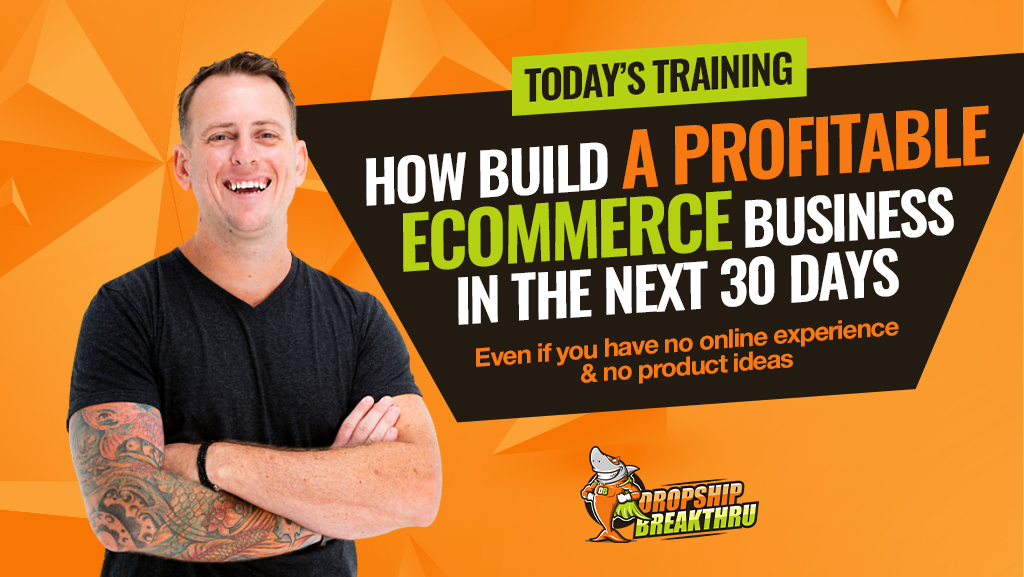
Want to start your own high ticket dropshipping business?
Watch this FREE, on-demand training session that will uncover the exact steps you need to take to launch your first high ticket dropshipping business in the next 30 days.
Decoding Product Research: How to Evaluate Your Best Ideas
Once you’ve brainstormed a list of possible product ideas, it’s time to do some research to identify the best ones.
If you want some one-on-one support to get you through the product selection process, check out our 5-day challenge. You can hop on a call with us to get help deciding on the right path. Not only do we do it ourselves, but we’ve helped over 400 people launch dropshipping businesses in the last 2 years alone!
But you can jump into it yourself with our step-by-step process for evaluating potential high ticket items for your dropshipping business:
Step 1: Always Put Your Customers First
Building a successful dropshipping business is all about relationships. Look past the transaction, and focus on the people behind the screen (seriously, we can’t stress this enough). They’re more than just sales – they’re people with unique needs, wants, and interests.
If you keep these people at the heart of your business, they’ll buy from you again and again. They’ll also refer their friends and family to you – and referrals are the backbone of any dropshipping business.
Start a spreadsheet for your market research, and add notes on the people and the product you’re evaluating. How well do they mesh?
Step 2: Check Out Retail Prices
Let’s talk about high ticket vs. low ticket dropshipping.
The ideal price range for a serious high ticket dropshipping product is $800 and up.
Just to reiterate: When you sell low ticket items (around $100 or less), your margins are small, meaning you have to sell a lot of products to make a decent profit. Focusing on a high ticket niche with quality items at higher prices means you don’t need a large sales volume to generate significant revenue.
Low ticket dropshipping usually goes hand-in-hand with having suppliers in other countries. These types of dropshipping are usually up to their necks in customer complaints about poor-quality products that arrive weeks (or even months) after customers place orders. Those complaints lead to returns and bad reviews. All of that eats away at profits.
Don’t do that to yourself!
Use Google’s “Shopping” tab to get a list of products that other advertisers are selling. Look for price trends, not outliers (so ignore the super high and super low prices). What’s the average price for the type of product you’re looking to sell?
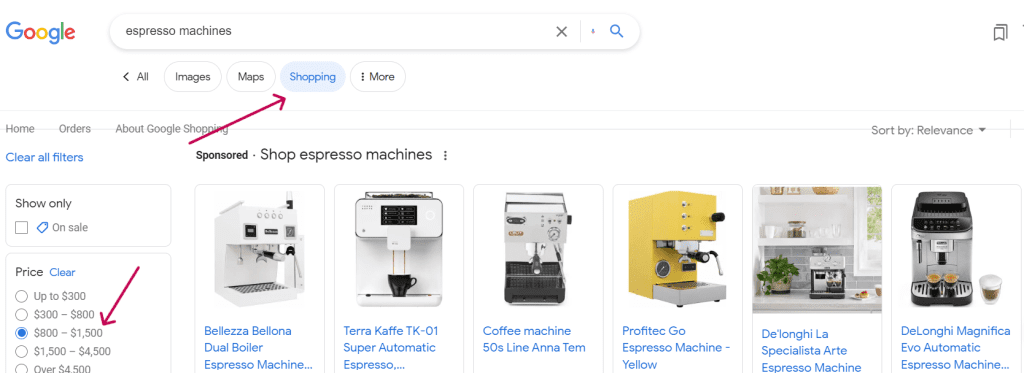
Add that data to your spreadsheet.
Step 3: Demand Capture
When you’re a dropshipper, aim to tap into existing demand. Or as we like to call it, demand capture. Your mission is to bring products directly into the path of those actively searching for them.
You’re not in the business of drumming up demand for your product. Instead, strategically position yourself to ride the wave of existing demand.
Consider the demand for high-end audio equipment created by brands like Bose or Sennheiser. Retailers like Best Buy and even Target have established relationships with these manufacturers so they can offer them to their customers.
Best Buy doesn’t create the demand for high-end audio equipment. It captures it.
So how do you determine whether there’s an existing demand for the product you’re researching? We recommend Keyword Surfer.
Once installed, you’ll see the Keyword Surfer icon next to your browser’s address bar.
- Enter a keyword related to your product: the extension will display data on the global monthly search volume (how many people worldwide search for that keyword monthly).
- Filter for your specific geographical market: Below the monthly search volume, you’ll find the search volume for individual countries – filter for your location.
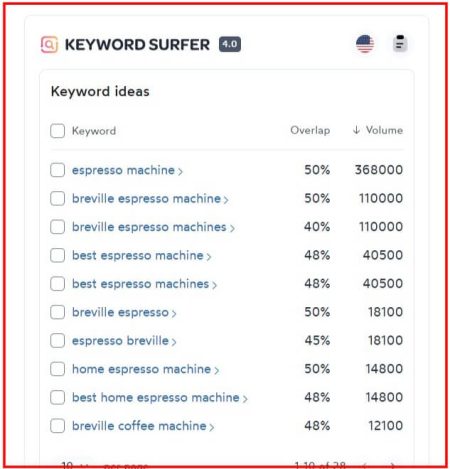

A high search volume indicates a large demand for your potential product. This can mean a lot of competition, which we’ll address in a second. But for now, just look for an enthusiastic market you can tap into.
Step 4: Identify Well-known & Trusted Suppliers
Now, you want to examine suppliers for the product you’re considering selling.
To find suppliers, go to Google and search for “[product name] manufacturers,” “[product name] suppliers,” or “[product name] distributors.”
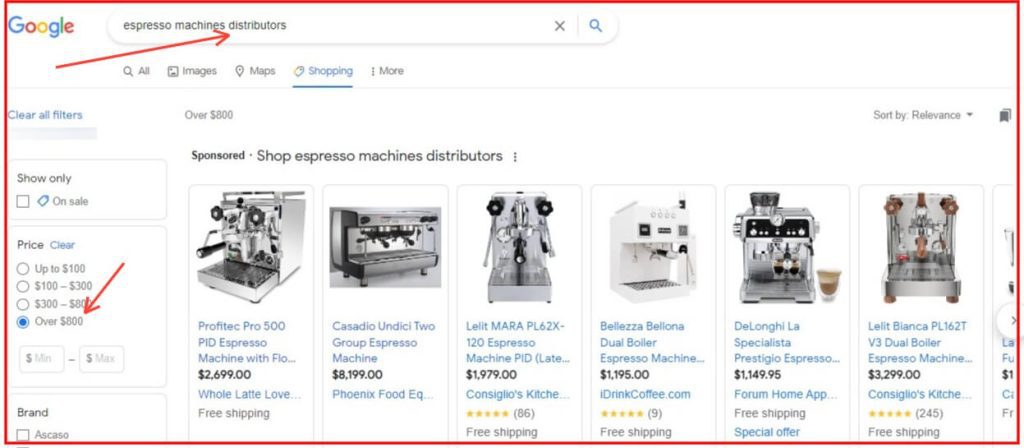

You can also go to other websites selling the product and see what brands they sell.
Look for several reputable suppliers of the product you’re researching.
Again, you’re looking for a sweet spot here – if there are a ton of suppliers, it may mean the market is flooded, and you’ll have trouble competing. If there aren’t enough, it may indicate there’s not a significant enough demand for the product.
All things to consider and add to your spreadsheet!
Step 5: Investigate Delivery Times
Every manufacturer or supplier will include delivery times on their website. You’re looking for high-quality suppliers that will ship locally (in your country) and quickly for domestic, high ticket products.
This is one of the biggest advantages of dropshipping high ticket products instead of low ticket ones.


Local suppliers for high ticket items will be more reliable and faster, and customer returns will be much easier to deal with.
Plus, if you choose a great supplier with quick delivery times, your customer is much less likely to receive a box full of disappointment when they order from you!
Step 6: Mine Reviews
Next, examine product reviews for your selected brands. Go to the supplier websites, Amazon, or your competitors and analyze product reviews.
Reviews provide first-hand insights from consumers about the quality of the product and whether customers are happy. This information will help you select high-quality products and avoid items that might have issues – which reduces the risk of returns, chargebacks, and customer complaints.
Step 7: Find Out If There’s Competition
When it comes to dropshipping – competition is often a major concern.
But not all competition is bad. The dropshipping market isn’t too competitive overall, but certain niches or products are more saturated than others.
It’s dynamic, and some products will gain or lose popularity over time. The trick is to identify products or niches that have the right balance of demand and competition.
Ideally, you want to see about 10 competitors. If there are fewer, that could mean there isn’t that high of a demand, and if there are A LOT more, that means there’s a huge demand, and you’ll get lost in the crowd.
Don’t let the fear of competition deter you. Instead, use it as a motivator to find your unique offering.
Wrapping Up the High Ticket Hunt
Remember that learning how to find dropshipping products isn’t just a quest for expensive items – it’s about insightful market analysis, capturing existing demand, and understanding your customers so you can deliver value.
By following the steps in this how-to guide, you’ll develop a keen sense for unearthing products you can dropship to build a profitable Ecommerce business that gives you the life you want.
Ready to take the next step? Check out our 5-Day challenge – by the end of 5 days, you’ll know what products to sell, who to sell them to, and the pathway to creating your own 7-figure dropshipping business.



Want to start your own high ticket dropshipping business?
Watch this FREE, on-demand training session that will uncover the exact steps you need to take to launch your first high ticket dropshipping business in the next 30 days.

Article by Ben Knegendorf
Ben Knegendorf realized at 29 he needed to find another career path. Since then, he’s:
- Successfully exited a high-ticket drop shipping business that he helped take from $1 to $11M annual revenue in just 2.5 years
- Eliminated $40,000+ of personal debt
- Joined Dropship Breakthru as co-owner in 2021
© Dropship Breakthru 2024

